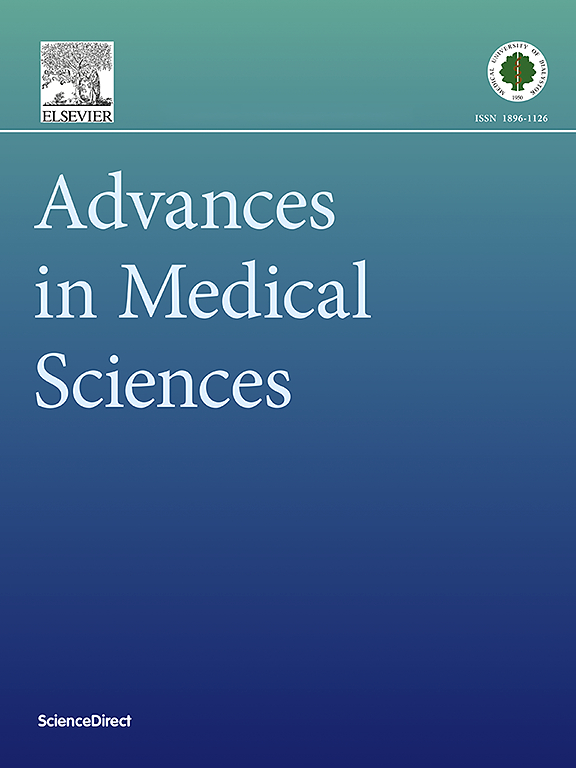C2HEST评分在肥胖和非肥胖人群中预测COVID-19临床结局的有效性——COLOS研究的亚分析
IF 2.6
4区 医学
Q3 MEDICINE, RESEARCH & EXPERIMENTAL
引用次数: 0
摘要
目的:心血管危险因素,特别是肥胖,是COVID-19预后不良的有力预测因素,尽管超重个体的预后仍不确定。确定评估肥胖对COVID-19严重程度影响的新工具对于早期风险分层至关重要。我们评估了c2hst评分系统预测住院COVID-19患者不良结局的能力。材料与方法:连续2183例确诊COVID-19住院患者纳入本研究。根据体格检查和既往病史,332名精心挑选的患者被分配到肥胖(n=191)和非肥胖(n=141)两个研究队列中的一个,并根据C2HEST评分结果分配到不同的风险层。结果:肥胖组共报告52例住院死亡(27.2%),非肥胖组住院死亡率为17%(24例报告)。在两个研究队列中,住院、3个月和6个月死亡率在C2HEST高危人群中最高,肥胖者分别为47.62%、57.14%和57.14%,非肥胖者分别为63.64%、72.73%和88.89%。在c2hst评分高危的患者中,非肥胖者更容易发生心肌损伤和急性心力衰竭,而肥胖者更容易发生急性肾损伤。结论:本研究显示c2hst评分在预测住院肥胖患者COVID-19不良结局方面的有效性和性能。在体重正常的队列中,C2HEST评分在风险预测方面更为精确。本文章由计算机程序翻译,如有差异,请以英文原文为准。
Usefulness of the C2HEST score in predicting the clinical outcomes of COVID-19 in obese and non-obese cohorts - subanalysis of the COLOS Study
Purpose
Cardiovascular risk factors, particularly obesity, are strong predictors of poor COVID-19 outcomes, though prognosis remains uncertain for overweight individuals. Identifying new tools to assess obesity's impact on COVID-19 severity is vital for early risk stratification. We evaluated the C2HEST-score system's ability to predict unfavorable outcomes in hospitalized COVID-19 patients.
Material and methods
Consecutive 2183 patients hospitalized due to confirmed COVID-19 were enrolled to this study. Based on the physical examination and past medical history, 332 carefully selected patients were assigned to one of two of the study cohorts, i.e. obese (n = 191) vs. non-obese (n = 141), and allocated to different risk-strata based on the C2HEST score result.
Results
A total of 52 in-hospital deaths (27.2 %) were reported in the obese cohort, while in the non-obese cohort the in-hospital mortality rate was 17 % (24 reported cases). The in-hospital, 3-month and 6-month mortality were the highest in the high-risk C2HEST stratum in both study cohorts, reaching respectively 47.62 %, 57.14 %, and 57.14 % in the obese and 63.64 %, 72.73 %, and 88.89 % in the non-obese cohorts. Among patients with the high-risk C2HEST-score, non-obese individuals were more likely to experience myocardial injury and acute heart failure, whereas obese individuals were more prone to develop acute kidney injury.
Conclusions
This study shows the usefulness and performance of the C2HEST-score in predicting the adverse outcomes of COVID-19 in hospitalized patients with obesity. In the cohort with normal body mass, the C2HEST score revealed to be far more precise in the risk prediction.
求助全文
通过发布文献求助,成功后即可免费获取论文全文。
去求助
来源期刊

Advances in medical sciences
医学-医学:研究与实验
CiteScore
5.00
自引率
0.00%
发文量
53
审稿时长
25 days
期刊介绍:
Advances in Medical Sciences is an international, peer-reviewed journal that welcomes original research articles and reviews on current advances in life sciences, preclinical and clinical medicine, and related disciplines.
The Journal’s primary aim is to make every effort to contribute to progress in medical sciences. The strive is to bridge laboratory and clinical settings with cutting edge research findings and new developments.
Advances in Medical Sciences publishes articles which bring novel insights into diagnostic and molecular imaging, offering essential prior knowledge for diagnosis and treatment indispensable in all areas of medical sciences. It also publishes articles on pathological sciences giving foundation knowledge on the overall study of human diseases. Through its publications Advances in Medical Sciences also stresses the importance of pharmaceutical sciences as a rapidly and ever expanding area of research on drug design, development, action and evaluation contributing significantly to a variety of scientific disciplines.
The journal welcomes submissions from the following disciplines:
General and internal medicine,
Cancer research,
Genetics,
Endocrinology,
Gastroenterology,
Cardiology and Cardiovascular Medicine,
Immunology and Allergy,
Pathology and Forensic Medicine,
Cell and molecular Biology,
Haematology,
Biochemistry,
Clinical and Experimental Pathology.
 求助内容:
求助内容: 应助结果提醒方式:
应助结果提醒方式:


